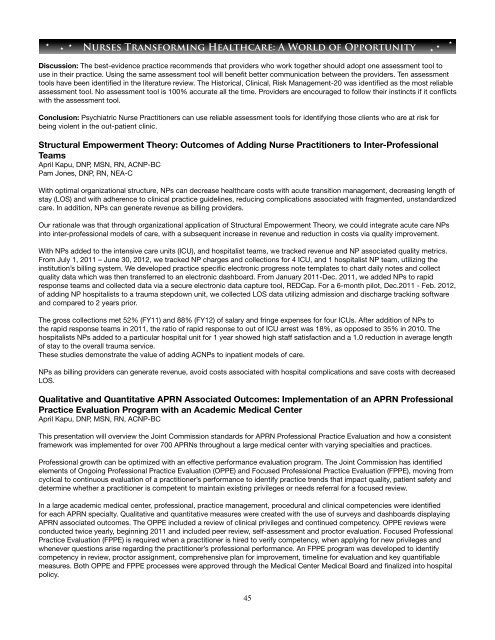2014 Tennessee Nurses Association Conference Yearbook
Create successful ePaper yourself
Turn your PDF publications into a flip-book with our unique Google optimized e-Paper software.
NURSES TRANSFORMING HEALTHCARE: A WORLD OF OPPORTUNITY<br />
Discussion: The best-evidence practice recommends that providers who work together should adopt one assessment tool to<br />
use in their practice. Using the same assessment tool will benefit better communication between the providers. Ten assessment<br />
tools have been identified in the literature review. The Historical, Clinical, Risk Management-20 was identified as the most reliable<br />
assessment tool. No assessment tool is 100% accurate all the time. Providers are encouraged to follow their instincts if it conflicts<br />
with the assessment tool.<br />
Conclusion: Psychiatric Nurse Practitioners can use reliable assessment tools for identifying those clients who are at risk for<br />
being violent in the out-patient clinic.<br />
Structural Empowerment Theory: Outcomes of Adding Nurse Practitioners to Inter-Professional<br />
Teams<br />
April Kapu, DNP, MSN, RN, ACNP-BC<br />
Pam Jones, DNP, RN, NEA-C<br />
With optimal organizational structure, NPs can decrease healthcare costs with acute transition management, decreasing length of<br />
stay (LOS) and with adherence to clinical practice guidelines, reducing complications associated with fragmented, unstandardized<br />
care. In addition, NPs can generate revenue as billing providers.<br />
Our rationale was that through organizational application of Structural Empowerment Theory, we could integrate acute care NPs<br />
into inter-professional models of care, with a subsequent increase in revenue and reduction in costs via quality improvement.<br />
With NPs added to the intensive care units (ICU), and hospitalist teams, we tracked revenue and NP associated quality metrics.<br />
From July 1, 2011 – June 30, 2012, we tracked NP charges and collections for 4 ICU, and 1 hospitalist NP team, utilizing the<br />
institution’s billing system. We developed practice specific electronic progress note templates to chart daily notes and collect<br />
quality data which was then transferred to an electronic dashboard. From January 2011-Dec. 2011, we added NPs to rapid<br />
response teams and collected data via a secure electronic data capture tool, REDCap. For a 6-month pilot, Dec.2011 - Feb. 2012,<br />
of adding NP hospitalists to a trauma stepdown unit, we collected LOS data utilizing admission and discharge tracking software<br />
and compared to 2 years prior.<br />
The gross collections met 52% (FY11) and 88% (FY12) of salary and fringe expenses for four ICUs. After addition of NPs to<br />
the rapid response teams in 2011, the ratio of rapid response to out of ICU arrest was 18%, as opposed to 35% in 2010. The<br />
hospitalists NPs added to a particular hospital unit for 1 year showed high staff satisfaction and a 1.0 reduction in average length<br />
of stay to the overall trauma service.<br />
These studies demonstrate the value of adding ACNPs to inpatient models of care.<br />
NPs as billing providers can generate revenue, avoid costs associated with hospital complications and save costs with decreased<br />
LOS.<br />
Qualitative and Quantitative APRN Associated Outcomes: Implementation of an APRN Professional<br />
Practice Evaluation Program with an Academic Medical Center<br />
April Kapu, DNP, MSN, RN, ACNP-BC<br />
This presentation will overview the Joint Commission standards for APRN Professional Practice Evaluation and how a consistent<br />
framework was implemented for over 700 APRNs throughout a large medical center with varying specialties and practices.<br />
Professional growth can be optimized with an effective performance evaluation program. The Joint Commission has identified<br />
elements of Ongoing Professional Practice Evaluation (OPPE) and Focused Professional Practice Evaluation (FPPE), moving from<br />
cyclical to continuous evaluation of a practitioner’s performance to identify practice trends that impact quality, patient safety and<br />
determine whether a practitioner is competent to maintain existing privileges or needs referral for a focused review.<br />
In a large academic medical center, professional, practice management, procedural and clinical competencies were identified<br />
for each APRN specialty. Qualitative and quantitative measures were created with the use of surveys and dashboards displaying<br />
APRN associated outcomes. The OPPE included a review of clinical privileges and continued competency. OPPE reviews were<br />
conducted twice yearly, beginning 2011 and included peer review, self-assessment and proctor evaluation. Focused Professional<br />
Practice Evaluation (FPPE) is required when a practitioner is hired to verify competency, when applying for new privileges and<br />
whenever questions arise regarding the practitioner’s professional performance. An FPPE program was developed to identify<br />
competency in review, proctor assignment, comprehensive plan for improvement, timeline for evaluation and key quantifiable<br />
measures. Both OPPE and FPPE processes were approved through the Medical Center Medical Board and finalized into hospital<br />
policy.<br />
45

















